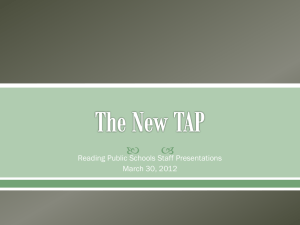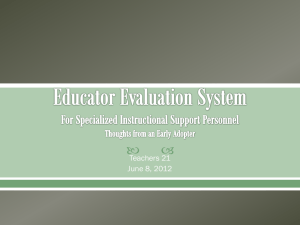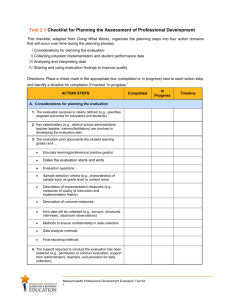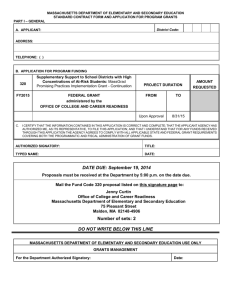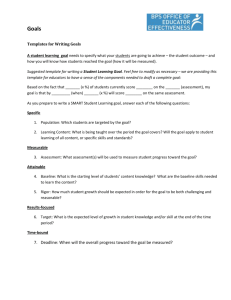Educator Evaluation System
advertisement
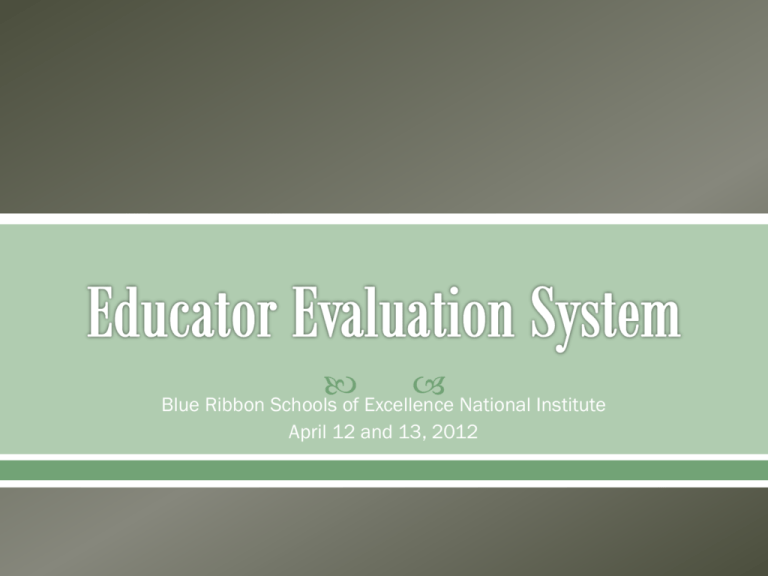
Blue Ribbon Schools of Excellence National Institute April 12 and 13, 2012 Donna Martinson, Teacher, Parker Middle School Elisabeth Shanley, Teacher, Parker Middle School Tara Herlihy, Teacher, Coolidge Middle School Margaret Guilbert, Teacher, Coolidge Middle School John Doherty, Superintendent of Schools Discussion of Educator Evaluation Regulations Comparison to Our TAP o What is the same o What is new How does this effect me as a teacher? Next steps in the process Questions http://www.doe.mass.edu/edeval/model/ 4 New DESE Regulations approved on June 28, 2011 Collaboratively Designed by o Massachusetts Teachers Association o Massachusetts Association of Secondary School Principals o Massachusetts Elementary School Principals Association o Massachusetts Association of School Superintendents o Department of Elementary and Secondary Education Requires evaluation of all educators on a license Designed to promote leaders and teachers growth and development Our current system is comparable to new DESE model Allowed us to give significant input into the process Developed a network with other school districts Attended professional development opportunities Piloted o Educator Plan with SMART Goals o Superintendent’s Evaluation Process o Principal Evaluation Process Representation from every school Compared current rubric with model rubric system Reviewed model contract language Will be involved in development of forms for September, 2012 Focuses on Educator Growth and not “Gotcha” Five Step Evaluation Cycle o o o o o Self-Assessment Analysis, Goal Setting, Educator Plan Development Implementation of Plan Formative Assessment (Midyear or Mid-cycle) Summative Evaluation (End of Year/Cycle Evaluation) Rubric for Evaluation Use of Artifacts for Evidence o Lesson Plans, Professional Development Activities, Fliers o Walkthroughs Differentiated Approach o o o o New Teachers Non-PTS Teachers PTS Teachers PTS Teachers who need additional support Use of SMART Goals Levels of Performance on Rubric o Exemplary (Exceeding the Standard) o Proficient (Meeting the Standard) o Needs Improvement (Progressing Toward the Standard) o Unsatisfactory (Does not meet standard) Specificity of Rubric o Standards o Indicators o Elements Four Standards instead of Six Fewer “Formal” Observations Multiple Measures of Student Performance (2013-14 School Year) Use of student surveys (2014-15 School Year) 5 Step Evaluation Cycle Continuous Learning Every educator is an active participant in an evaluation Process promotes collaboration and continuous learning Foundation for the Model Massachusetts Department of Elementary and Secondary Education10 Every educator uses a rubric to self-assess against Performance Standards Rubric is used to analyze performance and determine ratings on each Standard and Overall Rubric is used to assess performance and/or progress toward goals Part III: Guide to Rubrics Pages 4-5 Professional Practice goals – team and/or individual must be tied to one or more Performance Standards Evidence is collected for Standards and Indicators; rubric 11 should be used to provide feedback Massachusetts Department of Elementary and Secondary Education11 The Developing Educator Plan (Non-PTS Teachers and teachers new to a position) is developed by the educator and the evaluator and is for one school year or less. The Self-Directed Growth Plan (PTS Teachers) applies to educators rated Proficient or Exemplary and is developed by the educator. When the Rating of Impact on Student Learning is implemented (beginning in 2013-14), educators with a Moderate or High Rating of Impact will be on a two-year plan; educators with a Low Rating will be on a one-year plan. The Directed Growth Plan (PTS Teachers) applies to educators rated Needs Improvement and is a plan of one school year or less developed by the educator and the evaluator. The Improvement Plan (PTS Teachers) applies to educators rated Unsatisfactory and is a plan of no less than 30 calendar days and no longer than one school year, developed by the evaluator. District Strategy Superintendent Goals School Improvement Plans Principal Goals Classroom Practice Teacher Goals Student Achievement School Committee Standards (4)-Required in Regulations o Instructional Leadership (5 Indicators) o Management and Operations (5 Indicators) o Family and Community Engagement (4 Indicators) o Professional Culture (6 Indicators) Indicators (20)-Required in Regulations Elements (32)-May be modified, but most keep rigor Rubrics o A tool for making explicit and specific the behaviors and actions present at each level of performance. Part III: Guide to Rubrics Page 6 Massachusetts Department of Elementary and Secondary Education15 Example: Teacher Rubric o Standard I • “Standard I. Curriculum, Planning, and Assessment” o Indicator B • “Indicator I-B. Assessment” o Elements 1 & 2 • I-B-1: Variety of Assessment Methods • I-B-2: Adjustments to Practice Part III: Guide to Rubrics Appendix C, pages 2-4 Massachusetts Department of Elementary and Secondary Education16 Part III: Guide to Rubrics Page 6 Massachusetts Department of Elementary and Secondary Education17 “The educator’s performance significantly exceeds Proficient and could serve as a model for leaders districtwide or even statewide. Few educators—principals and superintendents included—are expected to demonstrate Exemplary performance on more than a small number of Indicators or Standards.” Part III: Guide to Rubrics Page 14 Massachusetts Department of Elementary and Secondary Education18 “Proficient is the expected, rigorous level of performance for educators. It is the demanding but attainable level of performance for most educators.” Part III: Guide to Rubrics Page 9 Massachusetts Department of Elementary and Secondary Education19 Educators whose performance on a Standard is rated as Needs Improvement may demonstrate inconsistencies in practice or weaknesses in a few key areas. They may not yet fully integrate and/or apply their knowledge and skills in an effective way. They may be new to the field or to this assignment and are developing their craft. Educators whose performance on a Standard is rated as Unsatisfactory are significantly underperforming as compared to the expectations. Unsatisfactory performance requires urgent attention. Standard I: Curriculum, Planning, and Assessment Standard II: Teaching All Students A. Instruction Indicator 1. Quality of Effort and Work A. Curriculum and Planning Indicator 1. Subject Matter Knowledge Standard III: Family and Community Engagement A. Engagement Indicator 1. Parent/Family Engagement 2. Student Engagement Standard IV: Professional Culture A. Reflection Indicator 1. Reflective Practice 2. Goal Setting 3. Meeting Diverse Needs 2. Child and Adolescent Development 3. Rigorous Standards-Based Unit Design 4. Well-Structured Lessons B. Assessment Indicator B. Learning Environment Indicator B. Collaboration Indicator 1. Variety of Assessment Methods 1. Safe Learning Environment 1. Learning Expectations 2. Adjustments to Practice 2. Collaborative Learning Environment 2. Curriculum Support B. Professional Growth Indicator 1. Professional Learning and Growth 3. Student Motivation C. Analysis Indicator C. Cultural Proficiency Indicator C. Communication Indicator 1. Analysis and Conclusions 1. Respects Differences 1. Two-Way Communication 2. Sharing Conclusions With Colleagues 2. Maintains Respectful Environment 2. Culturally Proficient Communication C. Collaboration Indicator 1. Professional Collaboration 3. Sharing Conclusions With Students D. Expectations Indicator 1. Clear Expectations D. Decision-Making Indicator 1. Decision-making 2. High Expectations 3. Access to Knowledge E. Shared Responsibility Indicator 1. Shared Responsibility F. Professional Responsibilities Indicator 1. Judgment 2. Reliability and Responsibility Standard I: Curriculum, Planning, and Assessment. The teacher promotes the learning and growth of all students by providing high-quality and coherent instruction, designing and administering authentic and meaningful student assessments, analyzing student performance and growth data, using this data to improve instruction, providing students with constructive feedback on an ongoing basis, and continuously refining learning objectives. Indicator I-A. Curriculum and Planning: Knows the subject matter well, has a good grasp of child development and how students learn, and designs effective and rigorous standardsbased units of instruction consisting of well-structured lessons with measurable outcomes. Element A-1. Subject Matter Knowledge o Proficient-Demonstrates sound knowledge and understanding of the subject matter and the pedagogy it requires by consistently engaging students in learning experiences that enable them to acquire complex knowledge and skills in the subject. Summative Rating Educators earn two separate ratings Exemplary Proficient 1-YEAR SELFDIRECTED GROWTH PLAN 2-YEAR SELF-DIRECTED GROWTH PLAN Needs Improvement DIRECTED GROWTH PLAN Unsatisfactory IMPROVEMENT PLAN Low Moderate High Rating of Impact on Student Learning (multiple measures of performance, including MCAS Student Growth Percentile and MEPA where available) Massachusetts Department of Elementary and Secondary Education26 Summative Rating Educators earn two separate ratings Exemplary Proficient 1-YEAR SELFDIRECTED GROWTH PLAN 2-YEAR SELF-DIRECTED GROWTH PLAN Needs Improvement DIRECTED GROWTH PLAN Unsatisfactory IMPROVEMENT PLAN Low Moderate High Rating of Impact on Student Learning (multiple measures of performance, including MCAS Student Growth Percentile and MEPA where available) Massachusetts Department of Elementary and Secondary Education27 Multiple sources of evidence inform the summative performance rating Massachusetts Department of Elementary and Secondary Education 28 Phase 1-Summative ratings based on attainment of goals and performance against the four Standards defined in the educator evaluation requirements (September, 2012) Phase 2-Rating of educator impact on student learning gains based on trends and patterns of multiple measures of student learning gains (September, 2013) Phase 3-Using feedback from students (for teachers) and teachers (for administrators)-(September, 2014) Collective Bargaining Process for Areas Not in Regulations Meeting with individual schools to discuss process further Training for Primary and Secondary Supervisors on Process and Calibration of Rubric TAP Committee Summer Work o New Forms o Planning professional development opportunities September Inservice o SMART Goal Development or “The” organizing initiative? Massachusetts Department of Elementary and Secondary Education31 Adopting the new MA Curriculum Frameworks 21st Century/Global Skills Anti-Bullying Professional learning communities Examining student work Data Teams Project Based Learning Common course/grade level assessments Elementary Report Cards Social Emotional Health BYOD Massachusetts Department of Elementary and Secondary Education32 This may be the most important initiative that you undertake in your district Look at this as an opportunity to improve teaching and learning and educator growth in your district Plan your strategy and process Train staff on how to write and implement SMART goals Collaboration is critical to the success of this implementation Link this system to the common core and assessment development Use the DESE materials Adopt the model rubric Transparent and ongoing open honest communication is critical Develop a logic model on how you will implement this process Involve your staff, school committee, and community early and often in the communication process

